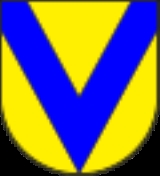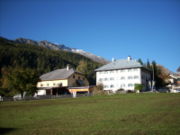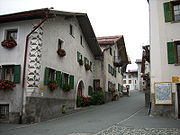
Valchava
Encyclopedia
Valchava is a village in the Val Müstair
(Müstair valley) of the canton
of Graubünden
(Grisons), Switzerland
. It was an independent municipality
in the district of Inn until on 1 January 2009 Valchava merged with Fuldera
, Lü, Müstair
, Santa Maria Val Müstair
and Tschierv
to form Val Müstair.

 Valchava has an area, , of 16.7 km² (6.4 sq mi). Of this area, 46% is used for agricultural purposes, while 33.9% is forested. Of the rest of the land, 1.4% is settled (buildings or roads) and the remainder (18.7%) is non-productive (rivers, glaciers or mountains).
Valchava has an area, , of 16.7 km² (6.4 sq mi). Of this area, 46% is used for agricultural purposes, while 33.9% is forested. Of the rest of the land, 1.4% is settled (buildings or roads) and the remainder (18.7%) is non-productive (rivers, glaciers or mountains).
The village is located in the Val Müstair sub-district (now Val Müstair municipality) of the Inn district. It consists of the linear village
of Valchava above Santa Maria Val Müstair
and the alpine settlements of Chaunt and Valpaschun. Until 1943 Valchava was known as Valcava.
, the gender distribution of the population was 51.0% male and 49.0% female. The age distribution, , in Valchava is; 19 children or 9.4% of the population are between 0 to 9 years old. 19 teenagers or 9.4% are 10 to 14, and 12 teenagers or 5.9% are 15 to 19. Of the adult population, 20 people or 9.9% of the population are between 20 to 29 years old. 31 people or 15.3% are 30 to 39, 30 people or 14.9% are 40 to 49, and 25 people or 12.4% are 50 to 59. The senior population distribution is 24 people or 11.9% of the population are between 60 to 69 years old, 16 people or 7.9% are 70 to 79, there are 5 people or 2.5% who are 80 to 89, and there is 1 person who is 90 to 99.
In the 2007 federal election
the most popular party was the SVP
which received 50.4% of the vote. The next three most popular parties were the SPS
(37.4%), the CVP
(8.9%) and the FDP
(3%).
The entire Swiss population is generally well educated. In Valchava about 45.6% of the population (between age 25-64) have completed either non-mandatory upper secondary education or additional higher education (either University or a Fachhochschule
).
Valchava has an unemployment rate of 0.33%. , there were 15 people employed in the primary economic sector and about 8 businesses involved in this sector. 14 people are employed in the secondary sector and there are 5 businesses in this sector. 24 people are employed in the tertiary sector, with 7 businesses in this sector.
The historical population is given in the following table:
Val Müstair
Val Müstair is a municipality in the district of Inn in the Swiss canton of Graubünden. It was formed on 1 January 2009 through the merger of Tschierv, Fuldera, Lü, Valchava, Santa Maria Val Müstair and Müstair.-Demographics:...
(Müstair valley) of the canton
Cantons of Switzerland
The 26 cantons of Switzerland are the member states of the federal state of Switzerland. Each canton was a fully sovereign state with its own borders, army and currency from the Treaty of Westphalia until the establishment of the Swiss federal state in 1848...
of Graubünden
Graubünden
Graubünden or Grisons is the largest and easternmost canton of Switzerland. The canton shares borders with the cantons of Ticino, Uri, Glarus and St. Gallen and international borders with Italy, Austria and Liechtenstein...
(Grisons), Switzerland
Switzerland
Switzerland name of one of the Swiss cantons. ; ; ; or ), in its full name the Swiss Confederation , is a federal republic consisting of 26 cantons, with Bern as the seat of the federal authorities. The country is situated in Western Europe,Or Central Europe depending on the definition....
. It was an independent municipality
Municipalities of Switzerland
Communes , also known as municipalities, are the smallest government division in Switzerland, numbering 2,596 . While many have a population of a few hundred citizens, the largest cities such as Zürich or Geneva also have the legal status of municipalities...
in the district of Inn until on 1 January 2009 Valchava merged with Fuldera
Fuldera
Fuldera is a village in the Val Müstair municipality in the district of Inn in the Swiss canton of Graubünden. In 2009 Fuldera merged with Lü, Müstair, Santa Maria Val Müstair, Tschierv and Valchava to form the municipality of Val Müstair.-Geography:...
, Lü, Müstair
Müstair
Müstair is a village in the Val Müstair municipality in the district of Inn in the Swiss canton of Graubünden. In 2009 Müstair merged with Fuldera, Lü, Switzerland, Santa Maria Val Müstair, Tschierv and Valchava to form Val Müstair....
, Santa Maria Val Müstair
Santa Maria Val Müstair
Santa Maria Val Müstair is a village in the Val Müstair municipality in the district of Inn in the Swiss canton of Graubünden. In 2009 Santa Maria Val Müstair merged with Lü, Müstair, Fuldera, Tschierv and Valchava to form the municipality of Val Müstair.-History:Sta...
and Tschierv
Tschierv
Tschierv is a village in the Val Müstair municipality in the district of Inn in the Swiss canton of Graubünden. In 2009 Tschierv merged with Fuldera, Lü, Müstair, Santa Maria Val Müstair and Valchava to form the municipality of Val Müstair.-History:...
to form Val Müstair.
Geography


The village is located in the Val Müstair sub-district (now Val Müstair municipality) of the Inn district. It consists of the linear village
Linear village
In geography, a linear village, or linear settlement, is a small to medium-sized settlement that is formed around a transport route, such as a road, river, or canal. Wraysbury, a village in Berkshire, is one of the longest villages in England....
of Valchava above Santa Maria Val Müstair
Santa Maria Val Müstair
Santa Maria Val Müstair is a village in the Val Müstair municipality in the district of Inn in the Swiss canton of Graubünden. In 2009 Santa Maria Val Müstair merged with Lü, Müstair, Fuldera, Tschierv and Valchava to form the municipality of Val Müstair.-History:Sta...
and the alpine settlements of Chaunt and Valpaschun. Until 1943 Valchava was known as Valcava.
Demographics
Valchava has a population of 203, of which 3.4% are foreign nationals. Over the last 10 years the population has decreased at a rate of -12%., the gender distribution of the population was 51.0% male and 49.0% female. The age distribution, , in Valchava is; 19 children or 9.4% of the population are between 0 to 9 years old. 19 teenagers or 9.4% are 10 to 14, and 12 teenagers or 5.9% are 15 to 19. Of the adult population, 20 people or 9.9% of the population are between 20 to 29 years old. 31 people or 15.3% are 30 to 39, 30 people or 14.9% are 40 to 49, and 25 people or 12.4% are 50 to 59. The senior population distribution is 24 people or 11.9% of the population are between 60 to 69 years old, 16 people or 7.9% are 70 to 79, there are 5 people or 2.5% who are 80 to 89, and there is 1 person who is 90 to 99.
In the 2007 federal election
Swiss federal election, 2007
Elections to the Swiss Federal Assembly, the federal parliament of Switzerland, were held on Sunday, 21 October 2007. In a few cantons, a second round of the elections to the Council of States was held on 11 November, 18 November, and 25 November 2007...
the most popular party was the SVP
Swiss People's Party
The Swiss People's Party , also known as the Democratic Union of the Centre , is a conservative political party in Switzerland. Chaired by Toni Brunner, but spearheaded by Christoph Blocher, the party is the largest party in the Federal Assembly, with 58 members of the National Council and 6 of...
which received 50.4% of the vote. The next three most popular parties were the SPS
Social Democratic Party of Switzerland
The Social Democratic Party of Switzerland is the largest centre-left political party in Switzerland....
(37.4%), the CVP
Christian Democratic People's Party of Switzerland
The Christian Democratic People's Party of Switzerland is a Christian democratic political party in Switzerland. It is the fourth-largest party in the National Council, with 31 seats, and the largest in the Council of States, with 15 seats. It has one seat, that of Doris Leuthard, on the Swiss...
(8.9%) and the FDP
Free Democratic Party of Switzerland
The Free Democratic Party was a classical liberal political party in Switzerland. It was one of the major parties in Switzerland until its merger with the smaller classical liberal Liberal Party, to form FDP.The Liberals on 1 January 2009....
(3%).
The entire Swiss population is generally well educated. In Valchava about 45.6% of the population (between age 25-64) have completed either non-mandatory upper secondary education or additional higher education (either University or a Fachhochschule
Fachhochschule
A Fachhochschule or University of Applied Sciences is a German type of tertiary education institution, sometimes specialized in certain topical areas . Fachhochschulen were founded in Germany and later adopted by Austria, Liechtenstein, Switzerland and Greece...
).
Valchava has an unemployment rate of 0.33%. , there were 15 people employed in the primary economic sector and about 8 businesses involved in this sector. 14 people are employed in the secondary sector and there are 5 businesses in this sector. 24 people are employed in the tertiary sector, with 7 businesses in this sector.
The historical population is given in the following table:
| year | population |
|---|---|
| 1850 | 208 |
| 1900 | 218 |
| 1950 | 252 |
| 2000 | 202 |
Languages
Most of the population speaks Rhaeto-Romance (80.7%), with German being second most common (18.3%) and Italian being third ( 1.0%). The Romansh speaking population speaks the Jauer dialect. In 1880 about 69% of the population spoke Romansh as a first language. In 1910 it was 72%, in 1941 it was 75% and in 1970 it was 90%. In 1990 about 92% understood Romansh even if it wasn't their first language, and in 2000 it was also 92%.| Languages in Valchava | ||||||
| Languages | Census 1980 | Census 1990 | Census 2000 | |||
| Percent | Number | Percent | Number | Percent | ||
| German German language German is a West Germanic language, related to and classified alongside English and Dutch. With an estimated 90 – 98 million native speakers, German is one of the world's major languages and is the most widely-spoken first language in the European Union.... |
44 | 20.18 % | 31 | 15.20 % | 37 | 18.32 % |
| Romanish | 168 | 77.06 % | 167 | 81.86 % | 163 | 80.69 % |
| Italian Italian language Italian is a Romance language spoken mainly in Europe: Italy, Switzerland, San Marino, Vatican City, by minorities in Malta, Monaco, Croatia, Slovenia, France, Libya, Eritrea, and Somalia, and by immigrant communities in the Americas and Australia... |
5 | 2.29 % | 6 | 2.94 % | 2 | 0.99 % |
| Population | 218 | 100 % | 204 | 100 % | 202 | 100 % |

